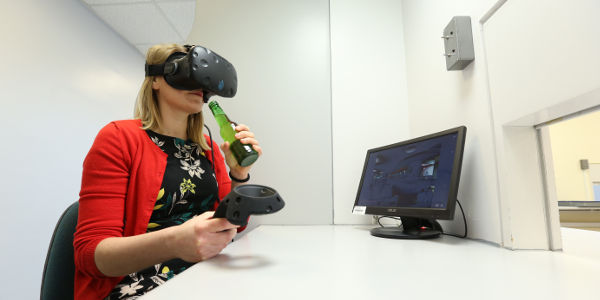
February 9, 2018, by Raphael Velt
Creating a virtual bar for a beer tasting experiment
This is a guest blog by Marit Nijman, PhD student in the Sensory Sciences Centre of the School of Biosciences.
Do you think you would feel differently about a beer if you have it in a pub as opposed to a plain white room? My PhD research has shown that consumers’ responses to products can be very different in different contexts.
Most products on the market have undergone some form of consumer testing before they are launched. Usually consumer testing takes place in a sensory laboratory with strict controls to ensure experimental error is minimised; the lab is a quiet and odourless environment with temperature and humidity control to avoid external sensory signals, the walls and furniture are neutral to avoid any form of visual bias, and the participants are served products in individual tasting booths to ensure their opinions are their own and they are not influenced by others. However, a sensory laboratory is not a usual place where people would go to consume food or drinks. As you can imagine, tasting a beer ‘sample’ in a sensory lab is a very different experience from having a pint in a pub. Therefore we are interested to test if testing in a lab is an optimal setting to be able to predict how consumers feel about beer products in the ‘real world’. The challenges when testing products in a real-life environment, say a bar for instance, is that researchers cannot control the number of people there, the noise, the music that is played etc. In other words there is no ‘experimental control’ over factors that might influence the results. So how can we measure consumers’ responses to beer products in a bar without losing the reliability of a controlled setting?
Virtual Reality (VR) can be a great way to re-create realistic environments, such as a bar, whilst maintaining some experimental control.
The Digital Research team at the University of Nottingham offers help to researchers to make use of advanced digital technologies such as VR, which they were promoting at a recent UNICAS sandpit event. At this event, it became clear that their knowledge and expertise in this area could benefit experiments in sensory and consumer science where the impact of consumption environments is highly topical area of research. Following on from this event, Dr Qian Yang (Sensory Science Centre Manager, School of Biosciences) and I met with Sophie, Raphael and Kamaljit from the Digital Research team. They showed us their exciting VR equipment and allowed us to try it out ourselves. We were really amazed about how realistic some of the environments in VR are so we were very keen to collaborate.
The digital research team have been very helpful in explaining possibilities for our research. They have introduced us to colleagues from the Mixed Reality Lab at Computer Science to help with the challenges in creating an existing bar in VR which we can use within our research to directly compare data collected in the real environment. Currently we are working together to tackle all sorts of practical issues, such as finding the best way to re-create an existing bar in VR and how participants will be able to drink beer with VR goggles on. The VR headset is quite large and makes it impossible to tilt a glass in order to take a sip and because you can’t see your own hands and arms in VR hand-to-mouth coordination is difficult. However, the Mixed Reality Team has experience with this so we are confident that a multi-disciplinary collaboration will result in a successful project. I look forward to updating you on the progress we have made in realising a Virtual Bar in my next blog.
Marit Nijman
No comments yet, fill out a comment to be the first

Leave a Reply